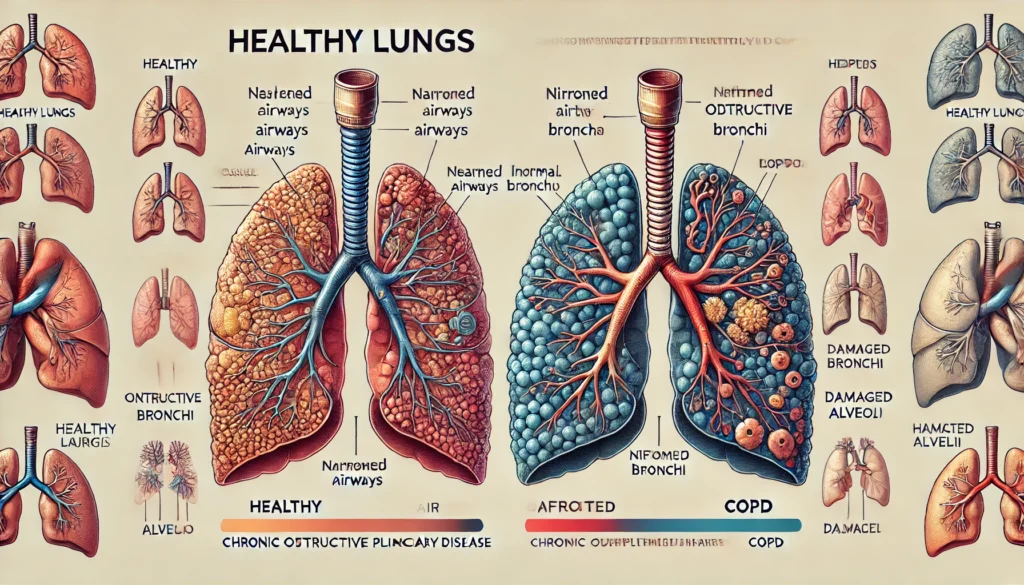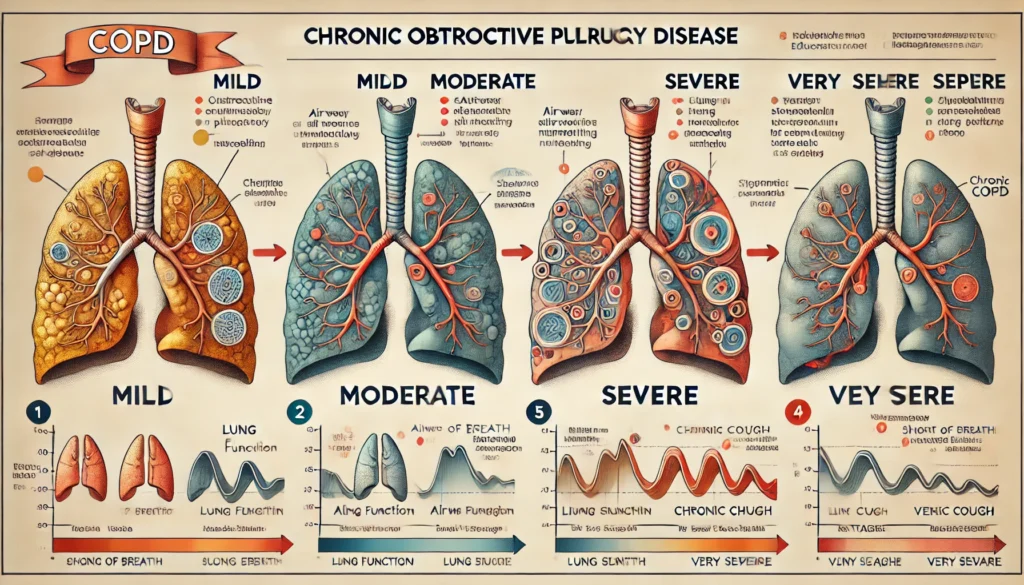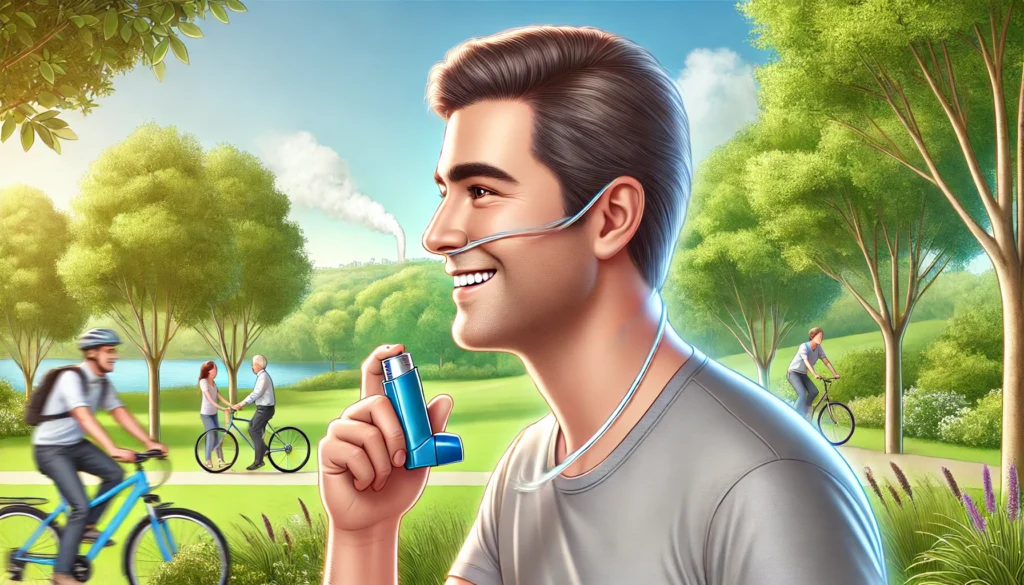
Chronic Obstructive Pulmonary Disease (COPD) is a chronic inflammatory lung disease that causes obstructed airflow from the lungs. It is characterized by long-term breathing problems and poor airflow. The main symptoms include shortness of breath, cough, and sputum production. COPD is typically caused by long-term exposure to irritating gases or particulate matter, most often from cigarette smoke.
In this comprehensive guide, we’ll explore 7 key facts about COPD, including its causes, symptoms, diagnosis, treatment options, and lifestyle changes for effective management. By the end of this article, you’ll have a thorough understanding of COPD and how to navigate its challenges.
Table of Contents
What is COPD? Understanding the Basics
COPD is a progressive disease, meaning it typically worsens over time. It includes two primary conditions: emphysema and chronic bronchitis.
- Emphysema: This condition gradually damages the air sacs (alveoli) in the lungs, reducing their elasticity. Over time, the walls between the alveoli break down, creating larger but fewer air sacs. This reduces the surface area available for oxygen exchange, making it difficult to breathe. Imagine trying to blow up a balloon that’s lost its stretch—it takes more effort for less airflow.
- Chronic Bronchitis: This involves long-term inflammation of the bronchial tubes, which carry air to and from the lungs. The inflammation leads to a persistent cough and excessive mucus production. Think of it as a clogged pipe: mucus narrows the airways, forcing the lungs to work harder to move air.
Global Impact:
- COPD affects over 380 million people worldwide and is the third leading cause of death globally, according to the World Health Organization (WHO).
- In the U.S. alone, 16 million adults have been diagnosed with COPD, and millions more may be undiagnosed, as reported by the American Lung Association.
While there is no cure, early diagnosis and proper management can significantly improve quality of life and slow disease progression.

Symptoms of COPD: What to Look For
COPD symptoms often develop slowly and worsen over time. Here’s a closer look at the most common signs:
- Shortness of Breath (Dyspnea):
- Initially occurs during physical activities like climbing stairs or walking.
- In advanced stages, it may happen even at rest.
- Example: A 60-year-old former smoker struggles to walk to the mailbox without pausing to catch their breath.
- Wheezing:
- A high-pitched whistling sound caused by narrowed or inflamed airways.
- Often worse in the morning or during cold weather.
- Chest Tightness:
- Described as a heavy weight on the chest or a sensation of being unable to take a deep breath.
- Chronic Cough:
- A persistent cough that produces mucus (sputum). The mucus may be clear, white, yellow, or greenish.
- Commonly referred to as a “smoker’s cough” in early stages.
- Frequent Respiratory Infections:
- Recurring colds, bronchitis, or pneumonia due to weakened lung defenses.
- Example: A patient with COPD may experience 3–4 severe colds annually, each lasting weeks.
- Fatigue and Lack of Energy:
- The extra effort required to breathe can leave patients feeling exhausted.
- Simple tasks like cooking or dressing become draining.
- Unintended Weight Loss:
- In late stages, the body burns extra calories to fuel labored breathing.
- Muscle wasting is common, further reducing strength.
- Swelling in Ankles, Feet, or Legs:
- Caused by cor pulmonale, a condition where COPD strains the right side of the heart, leading to fluid retention.
to know more about Alzheimer’s Disease please visit.
When to See a Doctor:
- If you experience these symptoms for more than a few weeks, seek medical advice. Early diagnosis is critical.

Causes and Risk Factors of COPD
COPD is primarily caused by long-term exposure to lung irritants. Let’s break down the key contributors:
- Tobacco Smoking:
- 85–90% of COPD cases are linked to smoking.
- Chemicals in cigarette smoke destroy lung tissue and trigger inflammation.
- Even secondhand smoke increases risk.
- Occupational Hazards:
- Jobs exposing workers to dust, chemicals, or fumes (e.g., mining, construction, welding).
- Example: A 55-year-old factory worker develops COPD after 30 years of inhaling chemical vapors.
- Air Pollution:
- Indoor pollutants: Burning biomass fuels (e.g., wood, coal) for cooking or heating in poorly ventilated homes.
- Outdoor pollutants: Vehicle exhaust, industrial emissions, and wildfire smoke.
- Genetics:
- Alpha-1 Antitrypsin Deficiency (AATD): A rare genetic disorder affecting 1 in 3,000–5,000 people. AATD reduces the liver’s production of a protein that protects the lungs from damage.
- Even non-smokers with AATD can develop COPD.
- Age and Gender:
- Most patients are diagnosed after age 40, as lung damage accumulates over decades.
- Historically more common in men, but rising smoking rates among women have narrowed the gap.
- Childhood Respiratory Infections:
- Severe or repeated lung infections (e.g., pneumonia) in childhood can impair lung development.

Diagnosing COPD: What to Expect
Diagnosis involves a multi-step process to rule out other conditions like asthma or heart failure:
- Medical History and Physical Exam:
- Your doctor will ask about smoking history, symptoms, and exposure to lung irritants.
- They’ll listen for wheezing or decreased breath sounds using a stethoscope.
- Spirometry:
- The gold standard for COPD diagnosis.
- You’ll blow into a tube connected to a spirometer, which measures:
- Forced Vital Capacity (FVC): Total air exhaled.
- Forced Expiratory Volume (FEV1): Air exhaled in the first second.
- A FEV1/FVC ratio below 0.70 confirms airflow limitation.
- Imaging Tests:
- Chest X-ray: Rules out other conditions like lung cancer.
- CT Scan: Provides detailed images of emphysema-damaged lungs.
- Arterial Blood Gas Test:
- Measures oxygen and carbon dioxide levels in the blood.
- Helps assess disease severity and need for oxygen therapy.
- Differential Diagnosis:
- Conditions with similar symptoms (e.g., asthma, congestive heart failure) must be ruled out.

Stages of COPD: From Mild to Severe
The Global Initiative for Chronic Obstructive Lung Disease (GOLD) classifies COPD into four stages:
- Stage 1 (Mild):
- FEV1 ≥ 80% predicted.
- Mild symptoms like occasional cough or shortness of breath during exertion.
- Many patients dismiss symptoms as “normal aging.”
- Stage 2 (Moderate):
- FEV1 50–79% predicted.
- Shortness of breath worsens, often prompting medical consultation.
- Stage 3 (Severe):
- FEV1 30–49% predicted.
- Daily activities like dressing become challenging.
- Frequent exacerbations (flare-ups) requiring hospitalization.
- Stage 4 (Very Severe):
- FEV1 < 30% predicted or chronic respiratory failure.
- Quality of life is severely impacted; oxygen therapy is often required.

Treatment Options for COPD: A Comprehensive Guide
COPD treatment aims to relieve symptoms, prevent exacerbations, and improve quality of life.
1. Medications
- Bronchodilators:
- Short-Acting (SABAs): Albuterol (quick relief during flare-ups).
- Long-Acting (LABAs): Salmeterol (daily maintenance).
- Inhaled Corticosteroids: Fluticasone reduces airway inflammation.
- Combination Inhalers: Advair (salmeterol + fluticasone) for dual action.
- Phosphodiesterase-4 Inhibitors: Roflumilast for severe COPD with chronic bronchitis.
2. Oxygen Therapy
- Prescribed when blood oxygen levels drop below 88%.
- Portable oxygen concentrators allow mobility.
3. Pulmonary Rehabilitation
- A 6–12 week program including:
- Exercise Training: Tailored to improve endurance.
- Nutritional Counseling: High-protein diets to combat muscle loss.
- Education: Inhaler techniques, energy conservation strategies.
4. Surgery
- Lung Volume Reduction Surgery (LVRS): Removes damaged lung tissue to improve diaphragm function.
- Lung Transplant: For patients under 65 with end-stage COPD.

Lifestyle Changes and Home Remedies for COPD
- Quit Smoking:
- Resources like nicotine patches, counseling, and apps (e.g., QuitNow!) can help.
- Exercise:
- Walking: Start with 10-minute sessions, gradually increasing duration.
- Tai Chi: Improves balance and breathing control.
- Diet:
- High-Protein Foods: Eggs, lean meats, and legumes to preserve muscle mass.
- Small, Frequent Meals: Reduces pressure on the diaphragm.
- Avoid Triggers:
- Use air purifiers to reduce indoor pollutants.
- Check air quality indexes before outdoor activities.
- Breathing Techniques:
- Pursed-Lip Breathing: Inhale through the nose for 2 seconds, exhale through pursed lips for 4 seconds.
- Diaphragmatic Breathing: Place a hand on the abdomen; breathe deeply to engage the diaphragm.

Complications of COPD: What You Need to Know
- Respiratory Infections:
- COPD patients are 3x more likely to develop pneumonia. Annual flu vaccines are critical.
- Heart Disease:
- Low oxygen levels strain the heart, increasing the risk of heart attacks.
- Lung Cancer:
- Smoking-related COPD patients have a 20–30% lifetime risk of lung cancer.
- Depression:
- 40% of COPD patients experience depression due to limited mobility and social isolation.

Advances in COPD Research and Treatment
- Biologic Therapies:
- Drugs like Dupilumab target specific inflammatory pathways.
- Stem Cell Therapy:
- Early trials explore regenerating damaged lung tissue.
- Smart Inhalers:
- Devices like Propeller Health track usage and send reminders via smartphone apps.
to know about more in understanding cancer comprehensive guide.
Living with COPD: Tips for Daily Management
- Pacing Activities: Break tasks into smaller steps to avoid overexertion.
- Energy Conservation: Use a shower chair or wheeled walker to reduce strain.
- Support Groups: Organizations like the COPD Foundation offer online communities.

Myths vs. Facts About COPD
| Myth | Fact |
|---|---|
| COPD only affects smokers. | 25–30% of COPD patients never smoked. |
| COPD is a death sentence. | With proper care, many live 10–20 years post-diagnosis. |
| Oxygen therapy means end-stage. | Oxygen can be used early to improve quality of life. |
Conclusion: Managing COPD Effectively
COPD is a challenging condition, but with the right knowledge and tools, it can be managed effectively. By staying informed, adhering to treatment plans, and making proactive lifestyle changes, patients can lead fulfilling lives.


